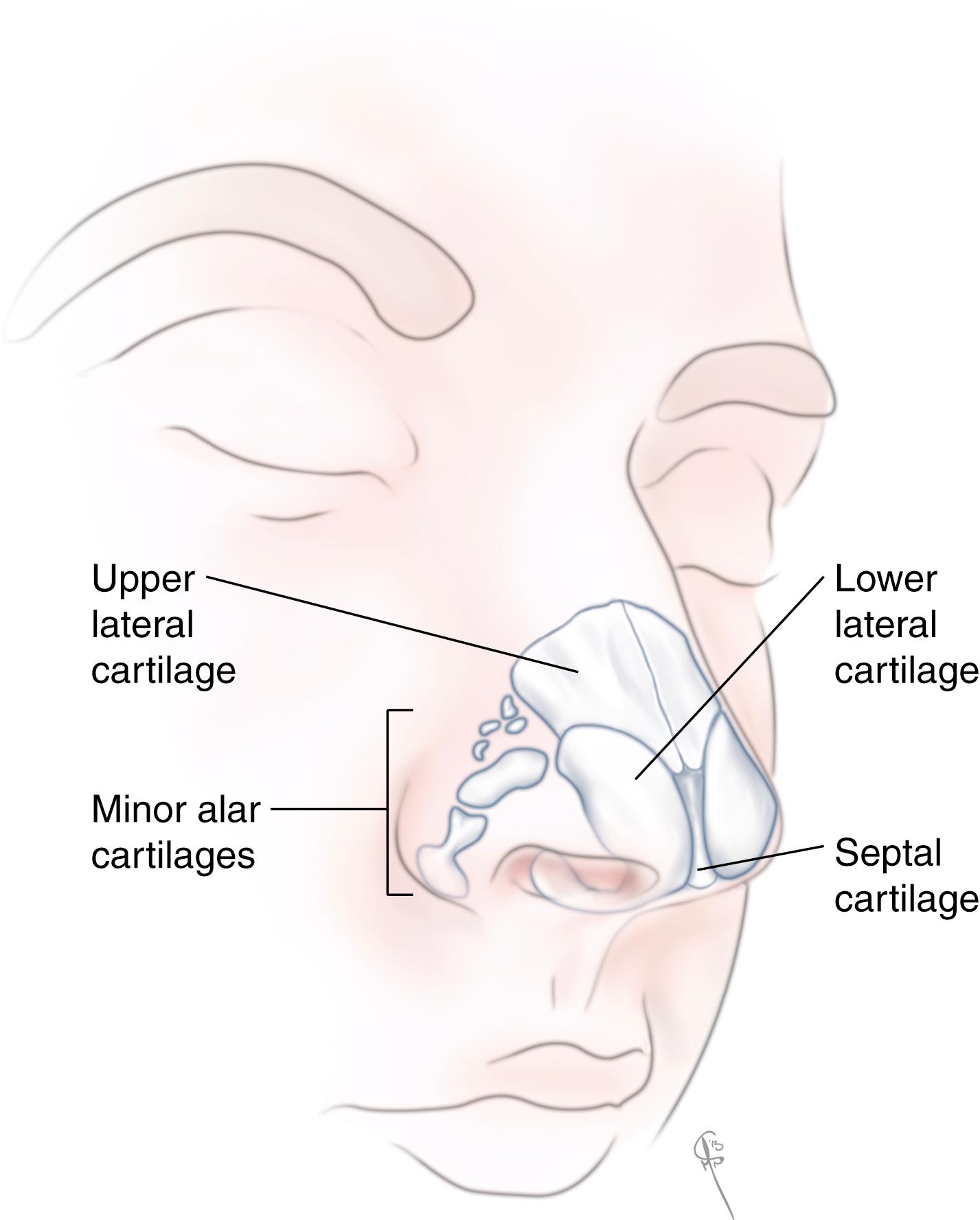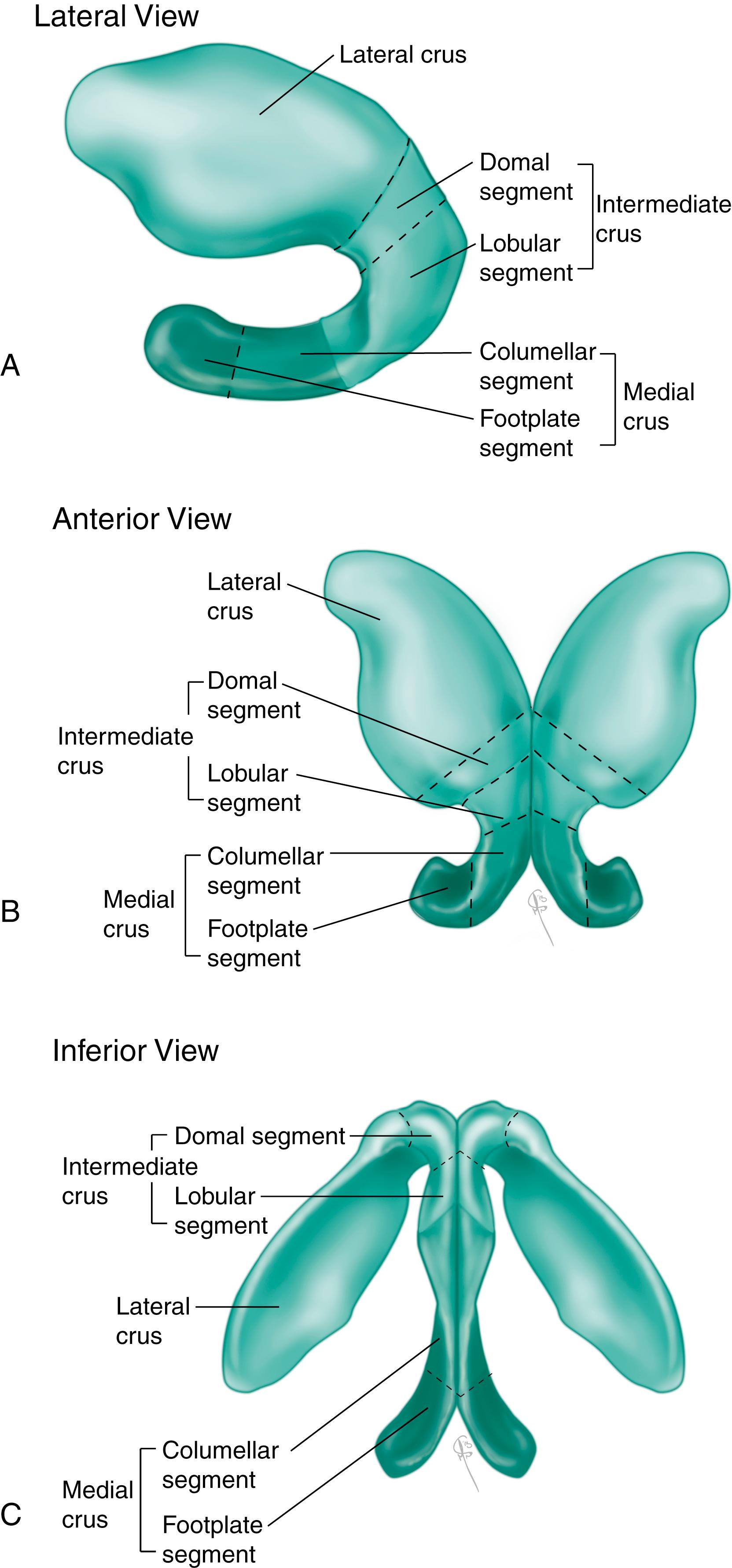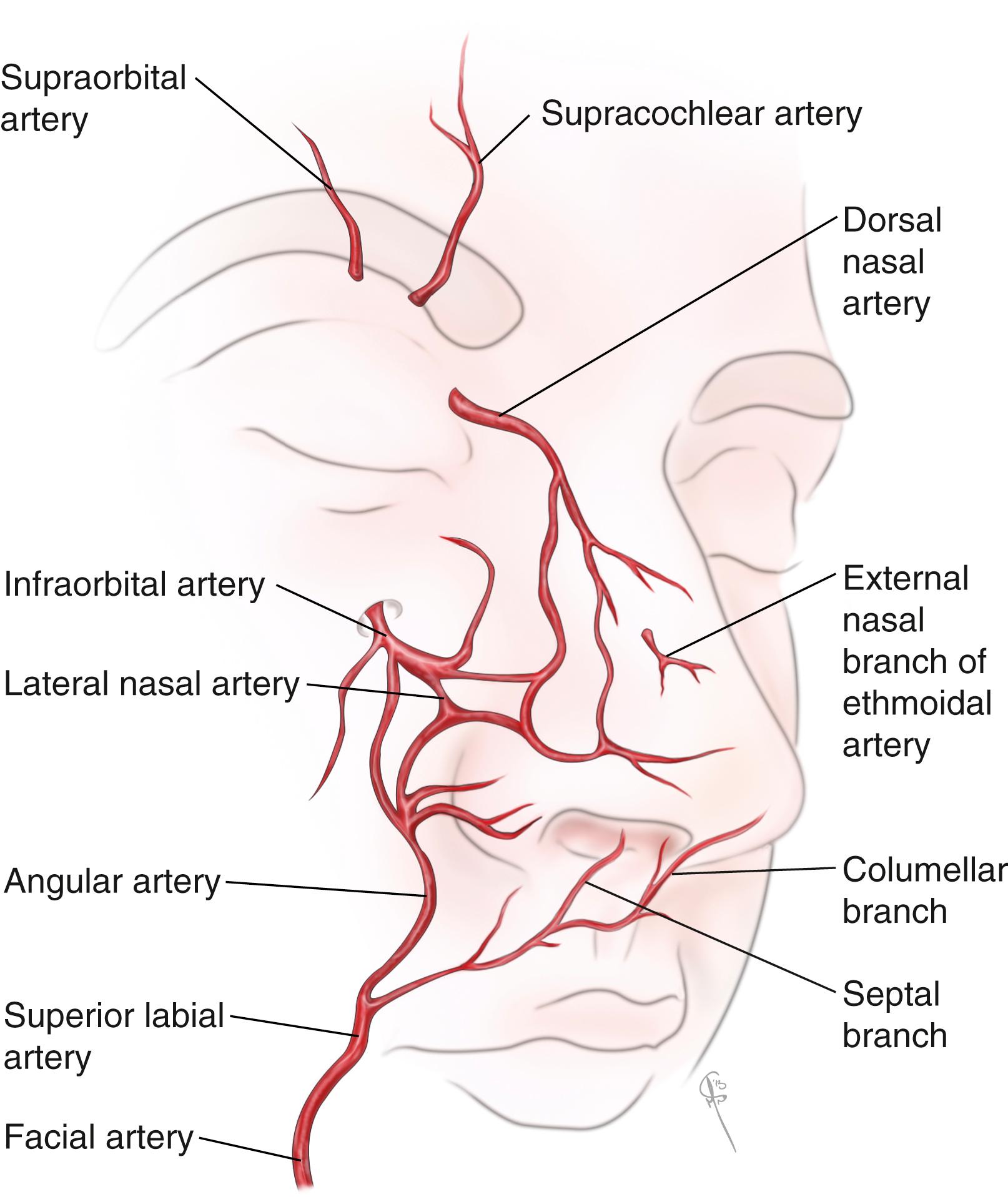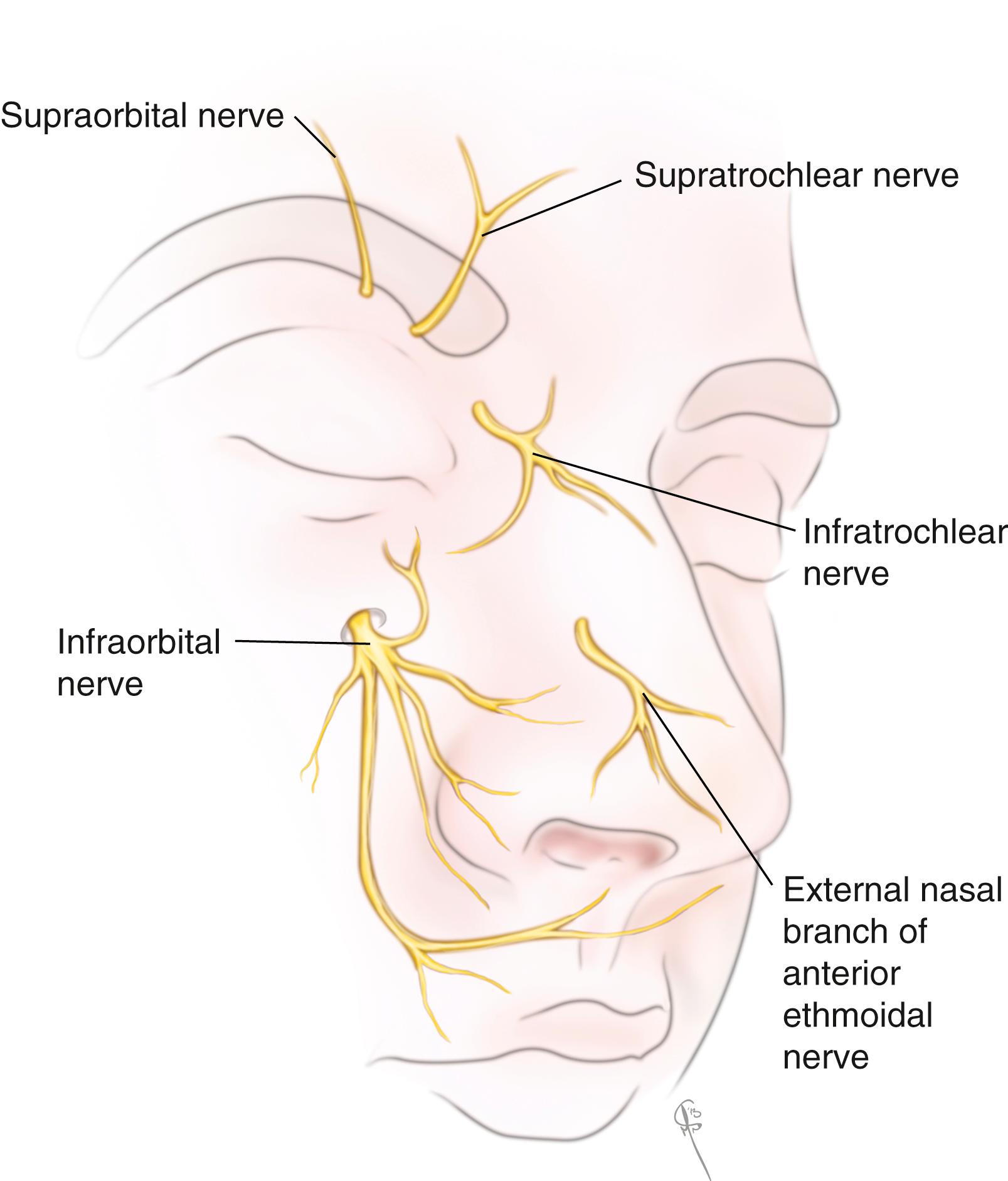Physical Address
304 North Cardinal St.
Dorchester Center, MA 02124
![]() For videos accompanying this chapter see ExpertConsult.com . See inside cover for access details.
For videos accompanying this chapter see ExpertConsult.com . See inside cover for access details.
The nose is a multifarious structure with critical mechanical and functional roles, which by virtue of its position, serves as the central and salient component of the face. Its relationship to surrounding structures is in part responsible for a harmonious, pleasing form as a whole. Functionally, the nose provides an airway and acts to warm, filter, and humidify air passing through it. Noses that deviate from ideal structural proportions – whether subtle variations of normal or more dramatic posttraumatic or neoplastic deformities – have motivated rhinoplasty surgeons since ancient India 800 BCE.
A thorough appreciation and understanding of relevant anatomy is crucial for all surgery. Obviously, recognition of the nuances and subtle variations of nasal anatomy is absolutely vital for execution of a successful rhinoplasty.
A thorough rhinoplasty evaluation must assess skin type and thickness. The surgeon must anticipate the advantages and limitations afforded by a particular skin type. In general, thin skin is unlikely to camouflage even minor irregularities in the underlying cartilaginous and osseous structures, particularly with grafting. In contrast, thick skin conceals imperfections in the nasal skeleton and may hide surgical flaws or reduce the desired definition intended from alteration of underlying cartilage and bone. Sebaceous skin can give the tip a bulbous appearance . The skin is thickest at the nasion. More caudally, the remaining upper half of nose tends to have skin that is thinner and more mobile than the lower half. In the tip area, there tend to be more sebaceous glands. However, in the infratip region, the columella and ala again are usually covered with thinner skin. 2,3.
An understanding of the bony and cartilaginous structural components of the nose should be complemented by correlation with landmarks of the surface anatomy ( Fig. 68.1 ). Caudal to the glabellar protrusion, the deepest point of the surface of the nose is referred to as the radix. The root of the nose, just caudal to the nasofrontal suture line, is referred to as the nasion, minor adjustments of which can change the overall character of the nose. The rhinion describes the position along the dorsum where the nasal bones articulate with the upper lateral cartilages and the pronasale refers to the region extending from the supratip break, including the tip and infratip lobule, to the anterior-most aspect of the columella. The tip-defining points are the anterior-most points of the nose corresponding to the intermediate crura of the lower lateral cartilages.

The bony vault is pyramidal in shape and comprises the paired nasal bones that articulate with the frontal bone superiorly and the ascending maxillary processes laterally. The bony pyramid is narrowest at the level of the intercanthal line and widens inferiorly. The nasal bones are thickest cephalically and become thinner caudally. , The nasal bones are supported superiorly at the nasofrontal suture line, laterally at their articulation with the ascending process of the maxilla, and dorsally at their fusion with the perpendicular plate of the ethmoid. The junction between the upper third and lower two-thirds of the nose where the cartilaginous septum meets the nasal bones is referred to as the “keystone area,” as this area is essential for structural support, and stabilizing the nasal dorsum for height and projection.
The upper lateral cartilages articulate with the septum and extend cephalically and laterally. The upper lateral cartilages are supported primarily by their connection with the nasal bones and frontal process of maxilla. On their deep surface, they are lined by perichondrium that is continuous with the septal perichondrium. Their articulation with the septum forms the internal nasal valve; the angle should be between 9 and 15 degrees.
The lower lateral cartilages (LLC) are paired structures in the caudal third of the nose that can be subdivided into three segments: the lateral, intermediate/middle, and medial crura ( Fig. 68.2 ). The lateral crus supports the alar rim. The scroll area is the region where the superior edge of the lower lateral cartilage curls downward as it meets the inferior edge of the upper lateral cartilage. This area provides some support for the internal nasal valve. Superior and lateral to the scroll area, one can find several small sesamoid cartilages connected by fibrous tissue that wraps around the alae laterally. , The intermediate crus has the most variability in shape and may be convex, boxy, broad or concave; it forms the tip-defining point. It should be noted that skin over this region is particularly delicate as there is a deficiency of subcutaneous tissue: the skin directly abuts the perichondrium necessitating meticulous dissection. The medial crura sit next to each other in the columella. The footplate is the area closest to the nasal spine where variable degrees of divergence exist. The columellar segment, the middle portion of the columella, extends towards the intermediate crura where the cartilages may diverge again to reach the tip-defining points.

Several analogies have been proposed to describe the dynamics of tip rhinoplasty, relating the medial and lateral crura of the lower lateral cartilages and their attachment to the caudal septum to tip support, projection, and rotation. The “tripod concept” of the nasal base is the most popular analogy for understanding the interdependent relationships of the nasal base structures. This theory proposes that the nasal base structurally functions like a tripod with the paired medial crura acting as one leg of the tripod and each of the lateral crura acting as one of the other two tripod legs . Altering the length or strength of the legs will result in changes of the rotation and projection of the tip. While the tripod theory has ample utility in the understanding and planning of surgery, , it has limitations in that it may not be the most accurate predictor of the true forces on the nasal tip. Westreich et al. proposed an alternate model, which extrapolates on the tripod concept described as a “cantilevered spring tripod.” They measured stiffness and elastic modulus of the different cartilages and found that the septal cartilage had the greatest tensile strength. They also found that the strength and support of the nasal tip depended greatly on the thickness of the cartilage and perichondrial attachments more than the elastic modulus of the particular cartilage. With these findings, they proposed considering the nasal tip as a cantilever from the caudal septum. .
The septum is comprised of bony and cartilaginous portions. The bony septum is made up of the perpendicular plate of the ethmoid bone superiorly, the vomer inferiorly and posteriorly, and the maxillary crest, which forms the caudal-most projection of the premaxilla, anteriorly and inferiorly. The cartilaginous septum is composed of a single continuous quadrangular cartilage that articulates with the vomer and the perpendicular plate of the ethmoid posteriorly and superiorly and is supported inferiorly by the maxillary crest. The anterior aspect of the quadrangular cartilage supports the nasal dorsum and provides tip projection. The anterior septal angle supports the nasal tip with attachments to the medial crura of the lower lateral cartilages. The posterior septal angle articulates with the anterior-most portion of the maxillary crest. The amount of cartilage in the quadrangular cartilage varies among patients and is typically less robust in non-Caucasian patients.
In the nose, the SMAS is a continuation of the subcutaneous musculoaponeurotic system, which is contiguous from the galea to platysma. Muscles associated with the nose within the SMAS can be categorized into elevators and depressors of the nasal tip. The elevator muscle group includes the procerus, levator labii superioris, alaque nasi, and the anomalous nasi. Depressors include the alar and transverse portions of the nasalis, the dilator naris posterior, depressor septi nasi, and compressor narium.
Understanding the blood supply of the nose is important in order to avoid ischemic consequences if this rich blood supply is inadvertently and sufficiently disrupted. The dorsal nasal artery, a branch of the ophthalmic artery, penetrates the orbital septum above the medial palpebral ligament and courses along the side of the nose, providing robust blood supply to the dorsal nasal skin. It ultimately anastomoses with the lateral nasal artery, a branch of the angular artery (itself the terminal branch of the facial artery), with numerous branches that enter the subdermal plexus thereby supplying the lateral surface of the caudal nose. The tip of the nose is supplied both by the external nasal branch of the anterior ethmoid artery (a branch of the ophthalmic artery), the columellar artery (a branch of the superior labial artery), and branches of the lateral nasal artery. The external nasal branch of the anterior ethmoid artery passes between the nasal bone and the upper lateral cartilage to supply skin of the nasal tip. Branches of the superior labial artery supply the nostril sill and columellar base ( Fig. 68.3 ). Intranasal blood supply is from branches of the anterior and posterior ethmoid arteries, the superior labial and greater palatine arteries, and the maxillary artery.

Venous drainage of the external nose generally consists of veins with names that correspond to the associated arteries, which veins drain through the facial vein, the pterygoid plexus, and ophthalmic veins, the pterygoid plexus and the facial vein. Lymphatic drainage of the nasal tip follows the same path and appears to be limited to the lateral walls, sparing the columella.
Branches of the second and third divisions of the trigeminal nerves provide sensory innervation of the nose while motor innervation is supplied by the zygomatic branch of the facial nerve. From V 2 , the ophthalmic nerve gives off the supratrochlear and infratrochlear nerves to supply sensation to the rhinion, radix sidewalls. The anterior ethmoid nerve gives off external branches that travel within the SMAS layer to supply sensation to the tip; therefore, careful dissection beneath the SMAS over the tip will preserve tip sensation. From V 3 , the maxillary nerve branches and supplies sensation to the lateral vestibule and columella ( Fig. 68.4 ).

The process of rhinoplasty begins with patient evaluation. Arguably, the foundation of a successful rhinoplasty is established at the initial patient visit including a thorough, accurate evaluation of the nose; its relation to the rest of the patient’s face; identification of appropriate and realistic goals given the patient’s anatomy; clear communication; and mutual understanding and agreement of surgical goals between the patient and the surgeon. A vital part of any successful rhinoplasty is the detection of the functional abnormalities. This begins with keen observation of mouth breathing, which often is unbeknown to the patients, and ends with circumspect examination of the internal and external nasal valves, septal deviation, and enlargement of the turbinates. Meticulous preoperative photodocumentation is crucial and life-size based planning or computer generated images of potential postoperative goals may be helpful in facilitating patient–surgeon discussion and establishing matching and achievable operative goals.
Become a Clinical Tree membership for Full access and enjoy Unlimited articles
If you are a member. Log in here